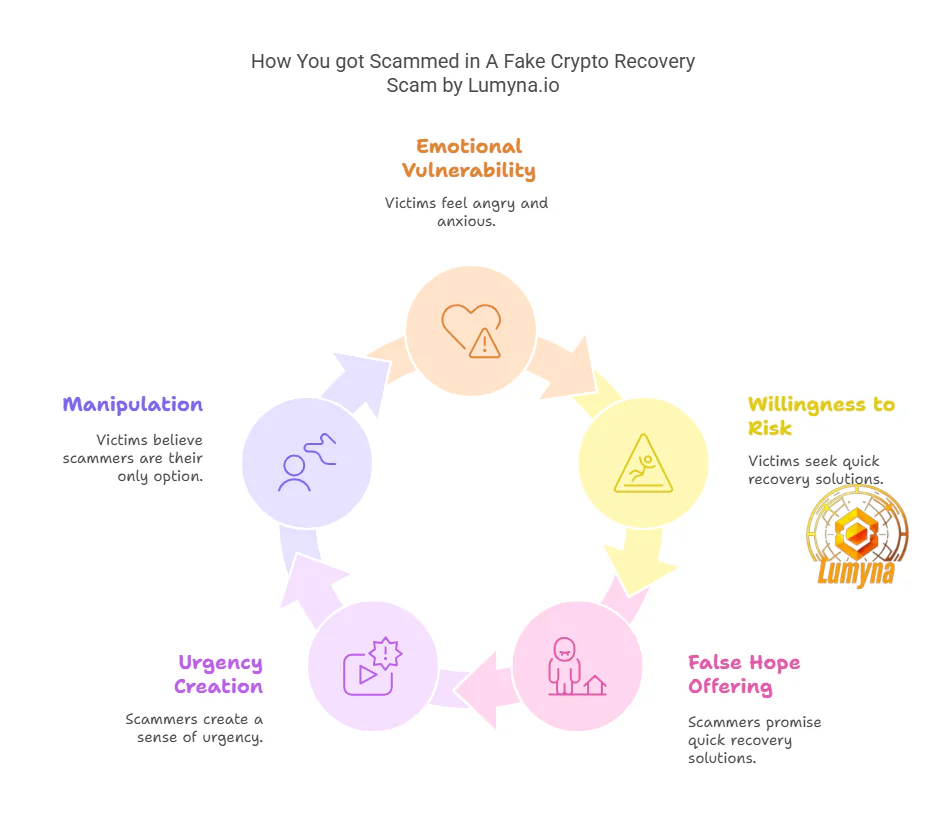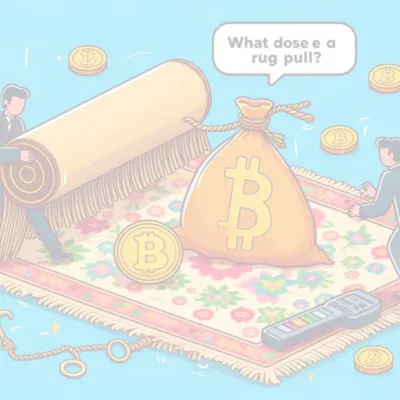The cryptocurrency industry has experienced explosive growth in recent years, drawing in millions of investors with promises of financial freedom and technological innovation. However, this meteoric rise has also given way to a darker side: a surge in crypto scams that exploit the decentralized and often unregulated nature of digital currencies. From Ponzi schemes and phishing attacks to rug pulls and fake initial coin offerings (ICOs), fraudsters have siphoned billions of dollars from unsuspecting victims. As the industry evolves, so too do the tactics of scammers, leaving regulators and law enforcement struggling to keep pace with the ever-shifting landscape of crypto crime.
Amid this chaos, a new breed of deceit has emerged: the “crypto recovery guru” scam. These fraudulent services prey on individuals who have already fallen victim to crypto fraud, promising to recover lost funds for a hefty upfront fee or a share of the supposed recovery. Posing as experts or legitimate firms, these scammers exploit the desperation and emotional vulnerability of their targets, only to disappear once payments are made, leaving victims doubly burned. The rise of such secondary scams highlights a vicious cycle in the crypto ecosystem, where one fraud begets another.
Victims of initial crypto scams often become easy targets for these recovery schemes due to their urgent desire to reclaim losses and a lack of knowledge about legitimate recovery options. Many are unaware that true recovery is rare, especially in a space where transactions are irreversible and anonymity reigns. This vulnerability is compounded by the absence of robust consumer protections in the crypto world, making it a fertile ground for exploitation.
Raising awareness and fostering education are critical to breaking this cycle. By equipping individuals with the tools to recognize red flags, such as unsolicited offers, guaranteed returns, or pressure tactics, the crypto community can better shield itself from both primary and secondary scams, paving the way for a safer digital economy.

What is a Crypto Recovery Guru Scam?
A Crypto Recovery Guru Scam is a fraudulent scheme in which scammers pose as experts, claiming to help victims recover lost or stolen cryptocurrency. These fraudsters exploit the desperation of individuals who have already suffered financial losses, promising to retrieve their funds in exchange for an upfront payment. However, instead of providing any legitimate recovery service, they disappear after taking the money, leaving the victim in an even worse financial situation.
Definition of Fake Crypto Recovery Services
Fake crypto recovery services operate under the guise of ethical hackers, blockchain specialists, or cyber forensic experts who claim to have advanced tools and insider knowledge to recover stolen cryptocurrency. These services often market themselves as “crypto recovery gurus,” promising quick and guaranteed results. In reality, crypto transactions are irreversible, and there is no method for simply “hacking” funds back into the victim’s wallet. These scams take advantage of victims’ desperation and lack of technical knowledge.
How Scammers Pose as Ethical Hackers or “Gurus”
Scammers adopt professional-sounding titles such as “Blockchain Recovery Expert,” “Cyber Crypto Investigator,” or “Digital Asset Retrieval Guru.” They often claim to have affiliations with law enforcement agencies, cybersecurity firms, or blockchain security companies.
Common tactics include:
- Displaying fake credentials and fabricated success stories.
- Claiming to use “dark web access” or “advanced recovery software” to track stolen crypto.
- Using technical jargon to sound legitimate (e.g., “private key decryption,” “seed phrase reconstruction”).
- Offering “consultations” to make their services appear professional.
- Ensuring the victim that the process is 100% risk-free and has a guaranteed success rate.
Common Platforms Where These Scams Operate

Scammers primarily operate on social media and messaging platforms where victims are likely to seek help. Some of the most common platforms include:
- Telegram: Fraudulent recovery groups and direct messages from scammers.
- WhatsApp: Personal outreach with fake success stories and promises.
- Reddit: Posting in crypto-related forums, offering to “help” desperate victims.
- Instagram & Facebook: Fake ads, testimonials, and influencer endorsements.
- Twitter/X: Scammers responding to posts about crypto losses, directing victims to fake services.
These scammers also target people who publicly post about their losses or seek help in forums. Victims are often contacted by “random users” who claim they have successfully recovered funds through a specific “guru.”
Join the Lumyna Crypto Forum
Want to Share your experience?
Fake Testimonials and Success Stories Used by Scammers
To appear legitimate, scammers fabricate positive reviews, testimonials, and success stories. They use:
- Photoshopped screenshots of “successful transactions.”
- Fake reviews on websites and forums claiming the recovery guru is “trustworthy.”
- Impersonation of real users by hacking or creating lookalike accounts.
- Video testimonials using AI-generated deepfake videos or actors.
By showcasing these false success stories, scammers build credibility and lure more victims into their trap.
🚨 Bottom line: There is no real “Crypto Recovery Guru.” If someone claims they can recover stolen crypto for a fee, it is almost certainly a scam.
How Crypto Recovery Guru Scams Work: A Step-by-Step Breakdown

Crypto recovery scams follow a carefully planned sequence, designed to lure desperate victims, build trust, extract money, and disappear. Below is a breakdown of how these fraudulent schemes typically operate:
Step 1: Initial Contact – Scammers Approach Victims Through Social Media, Email, or Forums
Scammers actively seek out victims who have lost cryptocurrency and are searching for ways to recover their funds. They typically target:
- People posting on forums like Reddit, Twitter, or Facebook, asking for advice on recovering lost crypto.
- Individuals who have been victims of investment scams, romance scams, or phishing attacks.
- People who have engaged with scam websites or Telegram groups—scammers often resell victim lists.
Common tactics for initial contact:
✅ Direct Messages (DMs): Victims receive a message from a so-called “crypto recovery expert” offering help.
✅ Fake Testimonials & Referrals: Scammers post in forums pretending to be satisfied clients, encouraging victims to contact them.
✅ WhatsApp & Telegram Spam: Fake support teams send unsolicited messages promising “100% guaranteed recovery.”
✅ Fake Company Websites & Ads: Scammers run ads or create fake cybersecurity company websites to appear credible.
At this stage, the scammer’s goal is to identify victims who are desperate and willing to pay for help.
Step 2: False Hope – Claims of Successful Recoveries, Often Using Fake Reviews
Once a victim engages with the scammer, they are flooded with fake success stories and reassured that their crypto can be recovered.
How scammers build trust:
🔹 Fake reviews & testimonials – They provide screenshots of “past successful recoveries.”
🔹 Complicated technical jargon – Scammers throw around terms like “private key decryption,” “reverse blockchain engineering,” or “seed phrase reconstruction” to sound credible.
🔹 Emotional manipulation – They sympathize with the victim, making them believe that they understand their loss.
🔹 Pretend to have connections with law enforcement – Some scammers claim they work with authorities or blockchain forensic firms.
🚨 Warning Sign: If someone claims they have recovered crypto for other people with a 100% success rate, it is almost certainly a scam. Crypto transactions are irreversible!
Step 3: Payment Demands – Requesting Upfront Fees for “Tools” or “Gas Fees”
Once the victim believes the scammer can recover their lost funds, they are asked to pay upfront fees to initiate the process. These fees are disguised as:
- Gas Fees – Fake transaction fees supposedly required to move funds on the blockchain.
- Software Purchase – Claiming they need to buy “hacking tools” to retrieve the stolen crypto.
- Blockchain Access Fee – A non-existent fee for gaining access to restricted blockchain data.
- Legal Processing Fees – Pretending to involve attorneys or regulatory agencies in the recovery process.
The amounts requested vary, but victims are often asked for hundreds or thousands of dollars before any “recovery process” begins.
🚨 Red Flag: A legitimate cybersecurity professional would never ask for upfront fees before successfully recovering any funds.
Step 4: Stringing Along the Victim – Asking for More Payments for Unforeseen “Complications”
Once the scammer receives the first payment, they don’t immediately disappear. Instead, they prolong the scam, squeezing more money from the victim by claiming there are unexpected problems.
Common excuses used to demand additional payments:
🔸 “The hacker is demanding a ransom to release the funds.”
🔸 “The wallet address has been locked, we need an extra security clearance.”
🔸 “We recovered part of your funds, but we need a fee to complete the transaction.”
🔸 “Authorities require a legal document fee before the funds can be transferred.”
Each of these excuses is designed to keep the victim paying until they either run out of money or realize they’ve been scammed.
🚨 Red Flag: If a “recovery expert” keeps asking for more money with no proof of progress, it’s a scam.
Step 5: Vanishing Act – Disappearing After Collecting Money, Leaving the Victim Worse Off
At a certain point, the scammer stops responding. They either:
❌ Block the victim on all platforms.
❌ Change their username or delete their account.
❌ Create a new identity and continue scamming others.
At this stage, the victim:
- Has lost more money than they initially did in the crypto scam.
- Has no legal recourse, since scammers operate anonymously.
- Feels humiliated and devastated, which can make them vulnerable to even more scams.
🚨 Final Warning: Once money is sent to a scammer, it is gone forever. They will not return it under any circumstances.
The Bottom Line: Crypto Recovery Scams Are Just a Second Scam
If you’ve lost cryptocurrency to fraud, it’s important to accept reality and avoid being scammed a second time.
- There is no such thing as a “crypto recovery guru.”
- No legitimate expert will ask for upfront payments.
- Once your crypto is stolen, it is almost impossible to recover.
The best approach is to report the fraud to authorities and blockchain forensic experts, but always be skeptical of anyone claiming they can “guarantee” recovery.
Why Crypto Recovery is Nearly Impossible?
Many victims of crypto scams or thefts desperately seek ways to recover their lost funds, but the harsh reality is that recovering stolen cryptocurrency is nearly impossible. This is due to the nature of blockchain technology, limited legal options, and the challenges of tracing stolen assets. While some rare cases of recovery exist, they are the exception, not the rule.
The Nature of Blockchain – Why Decentralized Transactions Are Irreversible
Unlike traditional banking systems, which allow institutions to reverse fraudulent transactions, blockchain technology operates on a decentralized, immutable ledger.
🔹 No Central Authority – Crypto transactions do not go through banks or financial institutions, meaning there is no authority to freeze, reverse, or dispute a fraudulent transaction.
🔹 Transactions Are Final – Once a transaction is confirmed on the blockchain, it is permanently recorded and cannot be altered or undone.
🔹 Anonymity of Wallets – Many scammers move stolen crypto through multiple wallets, decentralized exchanges (DEXs), and privacy-focused coins, making it extremely difficult to track.
🔹 Use of Mixers & Tumblers – Scammers often use crypto mixing services to launder stolen funds, breaking transaction trails and making tracing even harder.
Because of these factors, once funds are sent to a scammer, they are effectively gone forever.
Tracing vs. Recovering Crypto – The Difference Between Blockchain Analysis and Actual Recovery
Victims often hear about blockchain forensics and assume that tracing stolen funds means they can be recovered. However, tracing and recovery are two completely different processes.
✅ Blockchain Analysis (Tracing Crypto)
- Blockchain analytics firms (e.g., Chainalysis, CipherTrace, Elliptic) specialize in tracing transactions across the blockchain.
- They identify wallet addresses that received stolen funds and track further transactions.
- Law enforcement agencies may use this information in investigations.
❌ Crypto Recovery (Getting Funds Back)
- Even if stolen funds are traced, there is no guarantee they can be retrieved.
- Scammers use multiple wallets, offshore exchanges, and privacy coins to obscure the trail.
- Exchanges are not obligated to return stolen funds unless forced by legal action.
- Unless the scammer willingly returns the funds, recovery is nearly impossible.
🚨 Reality Check: Just because you know where your stolen crypto is does not mean you can get it back.
Limited Legal Avenues – How Authorities Handle Crypto Fraud and Its Limitations
While some victims report crypto scams to law enforcement, legal options for recovering stolen cryptocurrency are extremely limited.
✅ What Law Enforcement Can Do:
- Investigate large-scale crypto crimes (e.g., FBI, SEC, Europol).
- Freeze funds on centralized exchanges (if reported quickly and the funds are still there).
- Conduct sting operations or arrest criminals involved in major fraud schemes.
❌ Limitations of Law Enforcement:
- Slow response times – Many scams involve international criminals, making investigations lengthy and complex.
- Jurisdiction issues – Scammers often operate from countries with weak regulations or no extradition treaties.
- Lack of enforcement – Even if a scammer is identified, recovering funds is difficult unless assets are seized.
- Most stolen crypto is already laundered by the time authorities act.
🚨 Reality Check: Most individual victims will not get their crypto back through legal means. Authorities mainly focus on large-scale cases.
Cases Where Crypto Was Recovered (Rare Exceptions)
While crypto recovery is nearly impossible for most victims, there have been a few rare cases where authorities successfully recovered stolen funds:
🔹 Colonial Pipeline Bitcoin Ransom (2021)
- The FBI traced Bitcoin paid as ransom and recovered $2.3 million.
- They accessed the private keys of the hacker’s wallet, but this is extremely rare and not applicable to most cases.
🔹 Bitfinex Hack Recovery (2022)
- Law enforcement seized 94,000 BTC ($3.6 billion) linked to the 2016 Bitfinex hack.
- The funds were recovered only because the criminals made mistakes in laundering the stolen crypto.
🔹 Exchange-Freezing Stolen Funds
- If funds are sent to a centralized exchange (e.g., Binance, Coinbase, Kraken) and law enforcement acts quickly, exchanges may freeze the assets before they are withdrawn.
- This only works if the scammer is careless enough to leave funds on an exchange.
🚨 Final Reality Check: Unless your case involves millions of dollars and law enforcement interest, the chances of recovery are almost zero.
Conclusion: Prevention Is the Only Real Solution
Because recovering stolen cryptocurrency is nearly impossible, the best approach is to prevent scams in the first place:
✅ Use hardware wallets to store crypto securely.
✅ Never trust unsolicited messages or “recovery services”—they are scams.
✅ Enable multi-factor authentication (MFA) on all exchange accounts.
✅ Be cautious about sharing wallet addresses publicly to avoid becoming a target.
💡 Remember: Once crypto is stolen, you are unlikely to get it back. The best defense is not getting scammed in the first place.
Red Flags of a Crypto Recovery Guru Scam
The crypto recovery industry is full of scams, preying on victims who have already lost money. While it may be tempting to believe in a “recovery guru” who promises to get your funds back, these fraudsters often display clear warning signs. Here are the top red flags that indicate you’re dealing with a scam.
1. Asking for Upfront Payments – Legitimate Cybersecurity Experts Don’t Demand Upfront Fees
One of the biggest red flags is when a so-called crypto recovery expert asks for money upfront before recovering anything.
❌ How scammers justify upfront fees:
- Claiming they need to purchase specialized hacking tools to retrieve your funds.
- Saying that you must pay “gas fees” or “blockchain unlocking fees.”
- Asking for consultation or investigation fees before taking action.
✅ Legitimate cybersecurity experts operate differently:
- Ethical professionals work on a success-based model—they only take a percentage after recovery.
- Reputable firms don’t ask for money before proving any progress.
🚨 If someone demands an upfront payment to recover your crypto, it’s a scam.
2. Guarantees of 100% Recovery – No One Can Promise Successful Crypto Retrieval
Scammers often make bold claims, guaranteeing that they can recover all your lost cryptocurrency. This is a lie.
❌ Common scam promises:
- “We have a 100% success rate!” – Impossible, because most stolen crypto is already laundered.
- “We can recover any lost funds, no matter what.” – False, as blockchain transactions are irreversible.
- “If we don’t recover your funds, we’ll refund you.” – A trick to make victims feel safe about paying upfront.
✅ Reality Check:
- Even law enforcement agencies cannot guarantee successful recovery.
- Once crypto is stolen and moved through mixers or privacy coins, it’s virtually untraceable.
🚨 If someone promises 100% guaranteed recovery, they are lying.
3. No Verifiable Credentials – Lack of a Digital Footprint, Fake Websites, and Reviews
Scammers often create fake identities to appear legitimate but lack real credentials.
❌ How to spot fake credentials:
- No official website or only a basic, poorly designed site.
- No verified LinkedIn profile or work history in cybersecurity or blockchain forensics.
- Fake testimonials—often copied from other scam sites or featuring stock photos.
- No business registration—a quick Google search won’t show any official company records.
✅ How to verify credentials:
- Check for a real business license or company registration.
- Search for online reviews from independent sources (not just on their website).
- Look up their name and past work—legitimate experts have a track record.
🚨 If you can’t find verifiable credentials, you’re dealing with a scammer.
4. Urgent or Pressuring Tactics – Forcing Victims to Act Fast to “Avoid Losing Funds Forever”
Scammers use high-pressure tactics to force victims into making rash decisions.
❌ Common pressure tactics:
- “Act now before your funds are lost forever!” – False, since crypto transactions are final regardless of urgency.
- “We can only recover your funds if you pay within 24 hours.” – A tactic to prevent you from doing research.
- “The hacker is about to move your funds, we need immediate action!” – Lies designed to rush you into payment.
✅ Legitimate professionals do not rush clients:
- They provide clear explanations of how recovery efforts work.
- They never pressure victims into making immediate payments.
🚨 If someone is rushing you to act, it’s a scam.
5. Lack of Legal Backing – No Legitimate Business Registration, Office, or Contracts
Scammers operate anonymously, making it impossible to hold them accountable.
❌ Signs of legal non-existence:
- No business registration number or corporate filings.
- No physical office location—only generic online contact forms.
- No legally binding contracts outlining service terms and refund policies.
- Refusing to disclose their real name or company registration details.
✅ Legitimate crypto recovery firms provide:
- Official business registration details that can be verified online.
- Physical office addresses where clients can meet them.
- Legal contracts with clear terms and conditions.
🚨 If there is no legal backing, there is no legitimacy.
Conclusion: Don’t Fall for Crypto Recovery Scams
🚫 If someone contacts you claiming they can recover your stolen crypto, be extremely skeptical.
🚫 If they demand upfront fees, promise 100% success, or use pressure tactics, it’s a scam.
🚫 If they lack credentials, legal presence, or a verified reputation, do not trust them.
✅ Your best protection is awareness—never send money to a so-called “crypto recovery guru.”
Real Stories of Victims of Crypto Recovery Guru Scams
Crypto recovery scams don’t just steal money, they exploit desperation and emotional distress. Many victims of crypto scams, already suffering from financial loss, fall for a second scam when they try to recover their stolen funds. Here are real stories from victims who trusted fake crypto recovery gurus and lost even more money.
Case Study 1: “I Almost Took a Loan to Pay a Scammer”
A crypto user shared how they lost money in a crypto investment scam and then became a target for a crypto recovery scam. After posting about their loss on a forum, they were contacted by someone claiming to be a blockchain recovery expert.
The scammer reassured them that all lost funds could be recovered but required an upfront payment of $15,000 for “hacking tools.” The victim, desperate to recover their money, considered taking out a bank loan to pay the scammer. Luckily, they didn’t have enough money to make the payment. This saved them from being scammed a second time.
🚨 Lesson: Any so-called “expert” asking for an upfront fee is a scammer. Legitimate professionals don’t demand payments before delivering results.
Case Study 2: “I Sent $1,500, Then They Asked for More”
A user on a crypto forum described how they were approached by a recovery service on WhatsApp after they posted about being scammed. The scammer introduced themselves as an ethical hacker who had recovered crypto for many others.
Believing they had a real shot at recovering their stolen funds, the victim sent $1,500 to cover the “processing fees.” Soon after, the scammer claimed the process had run into complications and demanded another $960 for a “crash code.” When the victim refused, the scammer ghosted them completely.
🚨 Lesson: Scammers will keep demanding money until you either realize you’re being scammed or run out of funds. The moment someone asks for an extra fee, it’s a red flag.
Case Study 3: “They Stole Another $8,000 from Me”
Another Reddit user fell victim to a crypto trading scam, losing a significant amount of money. While searching for ways to recover it, they were referred to a “recovery guru” by another supposed victim (who was likely a scammer too).
The fake recovery service promised a 100% guarantee that their funds could be retrieved, but first, they needed $8,000 for “blockchain access fees.” Desperate to recover their savings, the victim paid the fee.
Once the money was sent, the scammer kept demanding more payments, using excuses like legal fees and transfer fees. The victim finally realized they were being scammed and cut off communication, but by then, it was too late, their money was gone.
🚨 Lesson: No real hacker, investigator, or cybersecurity firm can guarantee recovery, especially not in exchange for thousands of dollars upfront.
How Scammers Exploit Emotional Distress

Scammers thrive on desperation. When someone loses money in a crypto scam, they are:
💔 Emotionally vulnerable—angry, anxious, and desperate for a solution.
💰 Willing to take risks—hoping to recover what they lost, even if it means trusting strangers.
⏳ Looking for quick fixes—hoping that a “crypto recovery guru” can solve their problem instantly.
Crypto recovery scammers intentionally prey on these emotions by:
- Offering false hope when victims feel helpless.
- Creating a sense of urgency (“Your funds will be gone forever unless we act now!”).
- Manipulating victims into believing they are their only option.
🚨 Final Warning: If you’ve already lost money in a crypto scam, don’t let scammers take advantage of your emotions to steal even more. Real crypto recovery services don’t exist.
What to Do If You’ve Lost Crypto to a Scam?
Losing cryptocurrency to a scam is devastating, but the worst thing you can do is let desperation lead you into another scam. Many victims try to recover their funds, only to fall for fake crypto recovery services that steal even more money. Here’s what you should do instead.
Step 1: Accept Reality – Most Crypto Scams Result in Permanent Loss
The first and hardest step is accepting that your lost crypto is likely gone for good. Unlike traditional bank transactions, which can sometimes be reversed, crypto transactions are final.
Why is recovery so difficult?
❌ Blockchain is decentralized – No central authority can reverse transactions.
❌ Scammers move funds quickly – By the time you realize you’ve been scammed, the funds have likely been laundered.
❌ Crypto wallets are anonymous – Scammers use multiple wallets, making tracking difficult.
💡 Reality Check: The faster you accept this, the less likely you are to fall for a second scam. Scammers know victims are desperate and will try to exploit that emotion.
Step 2: Report the Scam – Alerting Authorities
Even though authorities may not be able to recover your funds, reporting the scam helps fight crypto fraud and may prevent others from being scammed.
📌 Where to report a crypto scam:
- FBI Internet Crime Complaint Center (IC3) – ic3.gov (U.S. victims)
- Securities and Exchange Commission (SEC) – If it was an investment scam: sec.gov
- Federal Trade Commission (FTC) – For general fraud: reportfraud.ftc.gov
- Local Police – File a report, especially if a significant amount was stolen.
- Crypto Scam Databases – Platforms like Scamwatch and Etherscan’s scam database allow you to flag suspicious wallet addresses.
🚨 Important: Scammers might pretend to be law enforcement and contact you offering recovery services—this is another scam.
Step 3: Notify Exchanges – Reporting Stolen Funds for Possible Freezing
If your stolen crypto was sent to a centralized exchange (Binance, Coinbase, Kraken, etc.), there’s a slim chance you can get the funds frozen before they are withdrawn.
🔹 How to report stolen funds to an exchange:
- Contact the exchange’s fraud or customer support team.
- Provide transaction IDs (TXIDs) and details of the scam.
- Request a temporary hold on the scammer’s wallet if the funds are still in their system.
💡 Reality Check: If the funds have already been withdrawn, there’s nothing the exchange can do.
Step 4: Blockchain Analysis – Consulting Forensic Crypto Analysts
If a large sum was stolen, you might consider hiring a blockchain forensics firm to trace the funds.
✅ What forensic firms do:
- Track where your stolen crypto went.
- Identify wallets involved in laundering the funds.
- Assist law enforcement in investigating.
❌ What they CANNOT do:
- Magically retrieve your funds.
- Hack the scammer’s wallet.
- Guarantee any recovery.
💡 Only consult a reputable firm (e.g., Chainalysis, CipherTrace), and never pay upfront for “guaranteed” recovery.
Step 5: Avoid Further Losses – Fake Recovery Services Are Just Another Scam
After losing crypto, many victims fall for fake recovery services. These scams operate by:
🔸 Promising 100% success when recovery is nearly impossible.
🔸 Asking for upfront fees for tools, gas fees, or legal processing.
🔸 Using fake testimonials to gain trust.
🚨 Golden Rule: If someone contacts you claiming they can recover your funds, it’s a scam.
Final Thought: Learn and Move On
Losing crypto is painful, but your best move is to accept the loss, report the scam, and avoid further scams. Prevention is the only real defense—educate yourself, secure your assets, and never trust “crypto recovery gurus.”
How to Protect Yourself from Crypto Scams and Fake Recovery Services
Preventing crypto scams is far easier than trying to recover lost funds. Scammers constantly evolve their tactics, but by taking the right precautions, you can protect your assets and avoid falling for fake recovery services.
1. Use Hardware Wallets – Store Crypto Securely Offline
One of the safest ways to protect your crypto from hackers and scams is by using a hardware wallet (cold wallet).
✅ Why hardware wallets are secure:
- Private keys are stored offline, making them immune to hacking attempts.
- Transactions require manual confirmation, preventing unauthorized transfers.
- No exposure to phishing attacks or malware targeting online wallets.
💡 Best Practices:
- Use trusted brands like Ledger, Trezor, or Keystone.
- Keep your seed phrase offline—never store it digitally.
- Avoid entering your private keys on any website—this is a common scam trap.
2. Verify Before Trusting – Check Websites, Reviews, and Credentials
Scammers create fake websites and impersonate crypto recovery experts to appear legitimate.
✅ How to verify before trusting:
- Check domain age – Fake websites are often newly created. Use who.is to check.
- Search for real reviews – Look beyond testimonials on their site (which are often fake).
- Verify credentials – Legitimate cybersecurity firms have a public track record and company registration.
- Be skeptical of unsolicited offers – If someone randomly messages you promising recovery, it’s a scam.
🚨 Red Flag: If they demand upfront payments, guarantee recovery, or pressure you to act quickly, walk away.
3. Educate Yourself – Learn How Crypto Transactions Work
Many victims fall for scams because they don’t fully understand how cryptocurrency and blockchain work.
✅ Key things to learn:
- Crypto transactions are irreversible – Once sent, funds cannot be recovered.
- Not your keys, not your crypto – If you don’t control the private keys, the assets aren’t truly yours.
- How scams operate – Recognizing common scam tactics helps you avoid them.
💡 Resources to improve your knowledge:
- Follow reliable crypto security blogs (e.g., Binance Academy, CoinDesk).
- Join legitimate crypto communities that discuss safety practices.
- Take free blockchain security courses on Coursera or Udemy.
🚨 The more you know, the harder it is for scammers to trick you.
4. Avoid Publicizing Crypto Losses – Scammers Target Victims Who Post Online
Many people, after losing crypto, post about their experience on social media or forums—unintentionally making themselves a target for fake recovery scams.
✅ How scammers find victims:
- Monitoring Reddit, Twitter, Telegram, and Facebook for posts about lost crypto.
- Sending private messages, claiming to know a “crypto recovery guru.”
- Using fake testimonials in response to public posts.
💡 What to do instead:
- Report the scam privately rather than announcing it online.
- Ignore and block anyone who contacts you promising to recover funds.
- Seek advice only from verified professionals and trusted crypto communities.
🚨 Final Tip: The best protection is staying cautious and informed—crypto security is in your hands.
Conclusion: The Hard Truth About Crypto Loss and Scams
Losing cryptocurrency to a scam is devastating, and the natural instinct is to try anything possible to get it back. Unfortunately, the hard truth is that once crypto is stolen, it is rarely recoverable. The decentralized nature of blockchain makes transactions irreversible, and scammers move funds through multiple wallets and laundering services, making tracking difficult.
However, what makes crypto scams even worse is that many victims lose money twice—first to the initial scam and then to fake recovery services that promise to retrieve lost funds. These so-called “Crypto Recovery Gurus” are just another scam, preying on people who are already vulnerable and desperate.
The Danger of “Too Good to Be True” Promises
Fake crypto recovery services use deceptive tactics to manipulate victims, offering false hope with guarantees of 100% recovery. They claim to have:
✅ Special hacking tools that can reverse blockchain transactions.
✅ Insider connections with law enforcement or exchanges.
✅ A secret method to unlock stolen funds.
🚨 Reality Check:
- No one can hack the blockchain to recover lost funds.
- Law enforcement rarely intervenes in individual cases unless millions are involved.
- Scammers disguise themselves as “recovery experts” to steal even more money.
By falling for these promises, victims end up deeper in financial trouble and even more heartbroken than before.
Seek Emotional and Financial Support—Not Another Scam
Losing crypto can cause severe financial stress, but instead of seeking recovery services, victims should:
💬 Talk to trusted friends or family – Emotional support is crucial.
📊 Reassess financial plans – Adjust budgets to recover from the loss.
💻 Report the scam – Authorities may not retrieve funds, but reporting helps prevent future scams.
📚 Learn from the experience – Strengthen knowledge about crypto security to avoid future losses.
Rather than chasing false hope, it’s better to accept the loss, move forward, and protect yourself in the future.
Final Reminder: There Is No Real Crypto Recovery Guru
🚫 If someone claims they can recover your lost crypto, they are lying.
🚫 If they ask for upfront fees, it’s a scam.
🚫 If they guarantee success, they are fraudsters.
The best way to fight crypto scams is through prevention—protect your funds, educate yourself, and never trust anyone promising a guaranteed recovery.
💡 Your best defense is awareness. Once crypto is lost, the smartest move is to protect what you still have.




